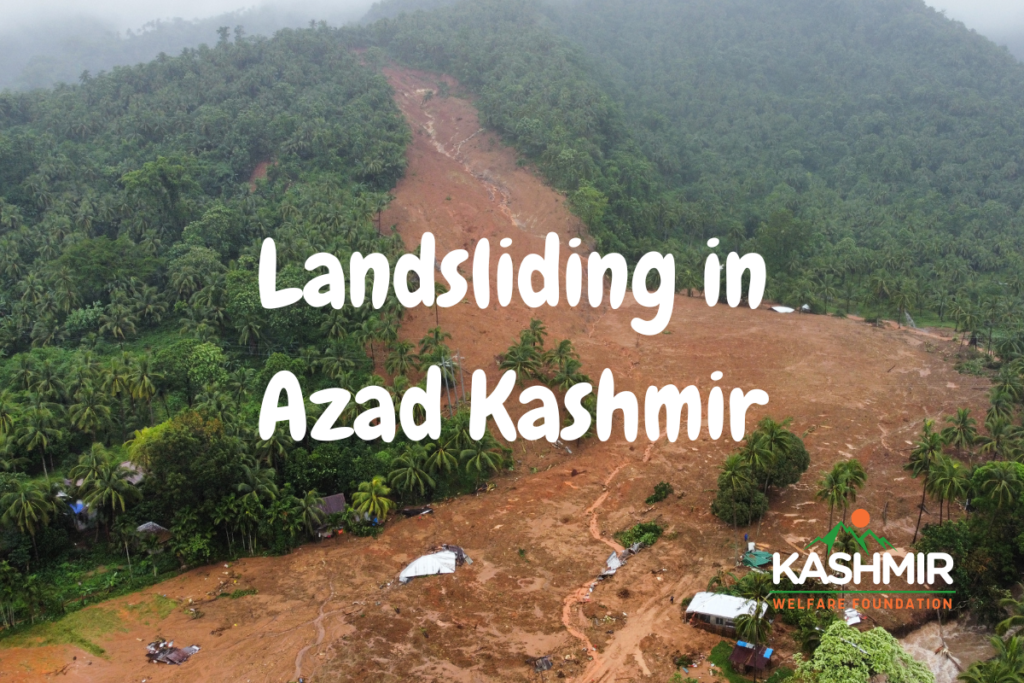Understanding Landslides in Azad Kashmir and Preventative Measures

Causes of Landslides in Azad Kashmir
Azad Kashmir, a region marked by its stunning but precarious landscapes, is highly susceptible to landslides due to a combination of geographical, geological, climatic, and anthropogenic factors. The first major aspect contributing to landslides in this area is the topography, characterised by steep slopes and rugged mountainous terrain, which predispose the land to gravitational failures. Additionally, the soil composition in Azad Kashmir, often consisting of loose, unconsolidated materials, cannot withstand heavy loads or movements, further heightening the risk of landslides.
A significant geological factor is the tectonic activity in the region, as Azad Kashmir lies in a seismically active zone. Frequent earthquakes and tremors destabilise the slopes, triggering landslides. Moreover, climatic conditions play a crucial role. The region experiences heavy rainfall, particularly during the monsoon season. Intense and prolonged precipitation saturates the soil, reducing its cohesion and making it more prone to slipping and sliding. Snowmelt during the warmer months also contributes to soil saturation, exacerbating the potential for landslide events.
Human activities further compound these natural vulnerabilities. Deforestation, often carried out for agriculture, timber, or development purposes, removes the vegetation that stabilises the soil. Without root systems to anchor it, the topsoil becomes much more likely to erode and slide. Unplanned construction, including roads and buildings on unstable slopes, alters the natural drainage systems and adds weight to already fragile slopes. Additionally, mining activities disturb the geological balance, creating voids and instability in the earth.
In essence, the confluence of natural and human-induced factors makes Azad Kashmir highly susceptible to landslides. Understanding these causes is crucial for developing effective preventative measures and minimising the impact of such disasters on the local population and infrastructure.
The Role of Tree Planting in Preventing Landslides
Tree planting plays a vital role in mitigating the risk of landslides in Azad Kashmir by stabilising soil and preventing erosion. The roots of trees anchor soil particles, reducing the likelihood of soil movement during heavy rainfall or seismic activity. Tree roots create a dense network within the soil, which enhances soil cohesion and increases its resistance to sliding. This natural reinforcement is essential in regions prone to landslides, as it significantly reduces the probability of soil instability.
Certain types of trees are particularly effective for preventing landslides. Deep-rooted species, such as oaks and pines, are beneficial because their extensive root systems delve deeper into the ground, providing more substantial support and stability. In contrast, shallow-rooted species like grasses and small shrubs are less effective in areas requiring robust soil reinforcement. Native tree species often emerge as the best option because they are well-adapted to the local soil and climatic conditions, ensuring better growth and longevity. Moreover, native species typically require less maintenance and offer additional ecological benefits, such as supporting local wildlife and maintaining biodiversity.
In Azad Kashmir, several government and community-led tree-planting initiatives have been instrumental in addressing the issue of landslides. Initiatives like the Green Pakistan Program and the Billion Tree Tsunami Programme have promoted large-scale afforestation and reforestation across vulnerable areas. These programs have yielded positive results, with thousands of hectares of land now covered with tree plantations that serve as natural barriers against soil erosion and landslides. Community involvement in these initiatives is crucial, as local participation ensures the sustainability and maintenance of the tree plantations over time.
Kashmir Welfare Foundation has also led in a number of similiar projects accros Azad Kashmir. You can donate towards our Green Kashmir Project here:
Safety Measures to Take During a Landslide
Understanding and recognising the signs of a potential landslide can be crucial for safety. Individuals and communities should be alert for unusual noises like rumbling or cracking, which might indicate shifting ground. Additionally, visible changes in the landscape, such as new cracks in the ground or alterations in water stream patterns, should prompt immediate attention and action.
Emergency preparedness is vital for minimising risks during a landslide. An effective first step is to create a detailed evacuation plan tailored to the specific geography and available infrastructure of the area. Identify safe zones, typically higher ground locations away from river valleys and other hazardous areas, which are less susceptible to landslides. Make sure all family members or community members are aware of these safe zones and how to reach them promptly.
Another critical aspect of preparedness is assembling an emergency kit. This kit should include essential items such as non-perishable food, water, first-aid supplies, required medications, flashlights, batteries, and important documents. Storing these items in a sturdy, accessible container ensures they can be quickly grabbed in the event of an emergency evacuation.
If caught in a landslide, moving to higher ground rapidly is essential. The downward force of a landslide can be incredibly powerful, often transforming river valleys into perilous zones due to accumulating debris and rising water levels. As a result, avoiding these areas can significantly increase the chances of safety. If escape is not possible, seek refuge under a sturdy piece of furniture to protect against falling debris and wait for help.
By recognising the early-warning signs of landslides and taking comprehensive, proactive measures, individuals and communities can better protect themselves from the devastating effects of this natural disaster. Preparation and swift action are key to ensuring safety during such critical times.
Its important to know that Landslides don’t always come alone, sometimes they are preceded by earthquakes or harsh weather.
Case Studies and Real-Life Examples
Azad Kashmir, has experienced several catastrophic landslides that underscore the importance of understanding their causes and implementing effective preventative measures. One notable landslide occurred in September 2014 in the village of Hattian Bala. Continuous heavy rainfall triggered the landmass movement, displacing homes and leading to casualties. The immediate impact was devastating; local infrastructure was severely damaged, and rescue operations were hampered by the blocked and unstable roads.
Another significant event was the 2005 Muzaffarabad Landslide, which coincided tragically with the devastating earthquake. This dual disaster exacerbated the landslide’s impact. Earthquake-induced liquefaction destabilised the slopes surrounding the city, leading to massive ground displacement. The aftermath saw hundreds of families displaced and a substantial economic downturn as the region struggled to rebuild.
In the area of Neelum Valley, interviews with local residents recount a harrowing night in early 2019. A sudden landslide, precipitated by deforestation and heavy snowfall, resulted in the loss of livestock and the destruction of several houses. According to survivors, the lack of adequate tree cover, which previously helped anchor the soil, played a critical role in the severity of the landslide. This real-life example underscores the importance of preventative measures like tree planting and sustainable land management practices.
The case studies and personal accounts illustrate the multifaceted causes of landslides, from natural elements such as rainfall and seismic activity to human activities like deforestation. By drawing lessons from these real-life examples, it becomes clear that effective preventative strategies—including tree planting, adherence to safety protocols, and the establishment of early warning systems—are vital to reduce the risk and impact of future landslides in Azad Kashmir.

